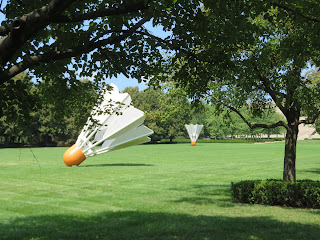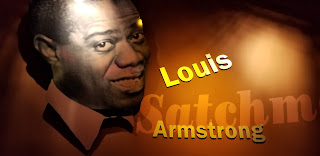Welcome to Kansas City!
As we came into this vibrant
city, our first stop was to view the Kauffman Center for Performing Arts, designed
by the architect Moshe Safdie:
Kansas City is home to
several wonderful museums. The Nelson-Atkins Museum of Art
houses a vast collection, including Egyptian and Medieval art.
 |
Outer Coffin of Meret-it-is
Egypt
|
 |
Inner Coffin of Meret-it-is
Egypt
|
 |
| Medieval Cloister |
Here are a couple of other
favorites:
 |
| Gaberndorf II by Lyonel Feininger |
 |
| Stammer Mill with Streaked Sky by Piet Mondrian |
When I turned the corner to go into another gallery, I was startled by this guard standing there. And then I realized that he wasn’t real! This guard is wearing a badge and uniform like the museum guards at the Nelson-Atkins wore in the 1970s.
 |
| Museum Guard by Duane Hanson |
This installation, Expedition to the Chimacloud by Saya Woolfalk, is best experienced with an iPad. When you hold the iPad up toward one of the pieces, the screen displays a kaleidoscope of colors!
Outside of the Museum is the
Donald J. Hall Sculpture Park which features many pieces by Claes Oldenburg and
Henry Moore.
 |
| Shuttlecocks by Claes Oldenburg and Coosje van Bruggen |
 |
| Sheep Piece by Henry Moore |
What a beautiful day we had for viewing these sculptures!
 |
| Ferment by Roxy Paine |
 |
| The Thinker by Auguste Rodin |
The region’s Federal Reserve
Bank is located in Kansas City.
Inside
of the bank is a Money Museum! The
current exhibition, Into the Fold, has several displays of currency made
into origami.
You can’t go into the Vault,
but there is a glass window where you can view a robot moving money into
it. This display gives one a visual idea
of how much $40 million dollars is:
We were lucky enough to be
visiting on the last Friday of the month when there is a tour of the art within
the Federal Reserve Bank! We couldn’t take
pictures in some parts of the building; however, here are a few of those that
we could take:
 |
| Silurian Sea by Emmi Whitehorse |
 |
| Cattlepond and Retreating Thunderstorm by Jeff Aeling |
 |
| America by Don Coen |
Art students were asked to make clay pots to represent staff mementos related to the bank – here are a few of their works:
We visited the Crown Center
for lunch and then took a tour at the Hallmark Visitor Center. This is a fascinating place that provides
excellent displays on the history of Hallmark.
I enjoyed looking at some of the oldest cards:
The Hallmark employees would
design giant Christmas cards each year as a holiday gift for Hallmark founder
J.C. Hall. In 1966 the tradition evolved
into creating a life-sized Christmas tree.
This tradition lasted until Mr. Hall’s death in 1982 and the trees are
now on display at the Visitors Center.
 |
| Angel Tree |
 |
| Crazy Quilt Tree |
Kansas City also has a museum
of contemporary art. The Kemper was designed
by the same architect that designed the Corning Museum of Glass (NY) and the Contemporary
Arts Museum of Houston – Gunnar Birkerts.
It features many famous
contemporary artists and sculptors like these favorites of mine:
 |
| Crying Giant by Tom Otterness |
 |
| Area Code by James Rosenquist |
 |
| Untitled by Roy Lichtenstein |
 |
| Cakes & Pies by Wayne Thiebaud |
Music still plays a role in
our adventures and we were thrilled to be able to go to the American Jazz Museum at the corner
of 18th and Vine! This museum provides the history of jazz through
interactive displays.
This exhibit area and
working club is called “The Blue Room”. It
was named for the Street’s Hotel Blue Room which was a famous nightclub in the
30’s and 40’s.
Soon after World War I ended,
the leaders in Kansas City decided to create a lasting monument to the men and
women who had served in the war. In 1919
the citizens of Kansas City raised more than $2.5 million in just 10 days! The Liberty Memorial was completed in 1926
and a museum was built later and opened in 2006.
After entering the museum
building, the entrance to the Main Gallery is a glass bridge suspended over a
field of poppies, symbolic of the Western Front poppy field.
The exhibits are in chronological
order, providing a deeper understanding of the events leading up to the war and
how the U.S. became involved.
This display shows artifacts
from war relating to music – very important for moral!
A film and this diorama representing
a barren landscape was very poignant:
The Pantheon de la Guerre,
a work of several French artists, was begun just after the war started to
depict the heroic deeds of the Allies. Exhibited as a type of cyclorama in Paris
in 1918, the final work is on a 400-foot-long and 40-foot-high canvas. The work was exhibited at the Chicago Exhibition
in 1933 and twenty years later it found its way to the Liberty Memorial. The mural was cut and configured to fit the
walls in the Museum buildings. Here are
photos of parts of the Pantheon de la Guerre:
Although our Airbnb was in Kansas, all of the above Kansas City sights are actually in Missouri.
Next we visit more of Kansas before heading to Oklahoma!






























